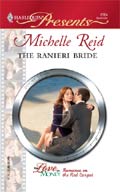Valentine’s Day has gone – thank goodness – but I thought I’d put a little bit of romance into your lives on this dreary February.
It all started when I searched for myself on Google and found I’d inadvertently written 26 novels…
OK I’m cheating, it is my namesake Michelle Reid, a romance writer for Harlequin Mills and Boon.
She grew up in Manchester where “Rough, tough, down-to-earth common sense was the main tool of survival not fanciful dreams of love and romance with the happy-ever-after prize at the end.” Her mother opened her mind to reading, and she soon became fascinated by the romantic conflicts and journeys threaded through the works of the Bronte sisters, Jane Austen, and of “the great and sparkling queen of Regency Romance Georgette Heyer.”
It was strange to see the familiar shape of my own name on the cover of 26 romance books, and it made me confront some of my prejudices against romantic fiction. Having studied science fiction at university, I’m used to combating assumptions about the dirty worlds of genre writing. I’ll happily defend sf, mysteries, horror, and fantasy against the snobbishness of the literary establishment, but romance, that’s full of sexist cliches about rippling muscles and pounding waves. Or is it? How many romance novels have I read recently? What do I know about the genre?
Something Michelle Reid wrote in her biography made me reconsider: “I find there is something really satisfying in tracking two people through the trials and tribulations of falling in love. These days everyone is so busy with their careers etc. that they don’t seem to have enough time left to dedicate to the more personal side of their lives so conflicts arise.” Romance is about escapism and the happy ending, but it is also about the journey, the growing self-awareness of the characters, and the ways in which they act towards each other. There is a strong sense of morality; the characters have to earn or realise their happiness. This is perhaps a parallel to the chivalric codes that shaped medieval romances.
Arthurian stories, Gothic novels, fantasy fiction, historical novels, scientific/planetary romance, the female bildungsroman or coming-of-age novels: they are all linked to genre romance, and so am I. The familiarity of my name and the sense of being shaped by those letters gives me a connection to my romance-writing namesake. It has brought me closer to romance novels, and it is inspiring to see the recognisable pattern of our shared name on their covers.
